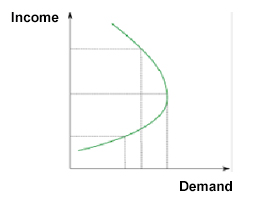Break the students into pairs or threes and give them the sheet with the arrow and a set of products (cut up). Ask them what they think would happen to the demand for the products if there was a significant rise in income (big rise, small rise, no change, small fall or big fall in demand). Get them to place their products on the line.
Then ask groups to justify their choices (probably go through product by product in open session: “Who had toilet roll as a big change? Why?” etc
The answers don’t matter – it’s all pretty subjective and in any case this allows you to get across the idea that YED isn’t a fixed value – it will actually vary by person – the income level of an individual will determine their attitude towards different products.
As a follow up, ask them to draw a blank graph on a miniwhiteboard with Y on the vertical axis and quantity on the horizontal axis. Then pick a product like bus travel and ask them to work in pairs to work out how demand will change as income steadily rises – suggest to them that they start thinking about what would be the case at zero income and what would then happen as income rises. Some of them should come up with something like this:

Initially demand will be zero until income rises to a certain level (people with no money don’t go on buses). After this point, bus travel is a normal good, but after income rises above a certain level, consumers start to take taxis or buy cars.